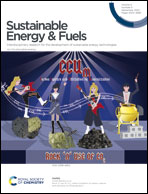Iron–cobalt–nickel trimetal phosphides as high-performance electrocatalysts for overall water splitting†
Abstract
Development of low-cost and high-efficiency electrocatalysts toward bifunctional hydrogen evolution reaction (HER) and oxygen evolution reaction (OER) is crucial for reversible fuel cells. Herein, we fabricate an N/P-codoped Fe/Co/Ni-containing graphene-based material by deriving metal–organic frameworks (MOFs). The homogeneous dispersion of tri-metallic Fe/Co/Ni in the MOF-derived carbon materials favors the formation of heterojunctions between the resulted different phosphides, which speed up electron transfer and improve the electrocatalytic properties. The graphene support can efficiently protect the phosphides from degradation during the catalytic process. The obtained FeCoNiP@NC catalyst shows low HER overpotential of 93 and 187 mV at a current density of 10 mA cm−2 in 0.5 M H2SO4 and 1.0 M KOH, respectively. In addition, The FeCoNiP@NC exhibits low OER overpotential of 266 mV at 10 mA cm−2 in 1.0 M KOH solution. The FeCoNiP@NC electrocatalyst can work as bifunctional electrode materials for overall water splitting in alkaline electrolyte with good stability. FeP and CoP play a dominant role in HER, while CoP plays a main role in OER.



 Please wait while we load your content...
Please wait while we load your content...